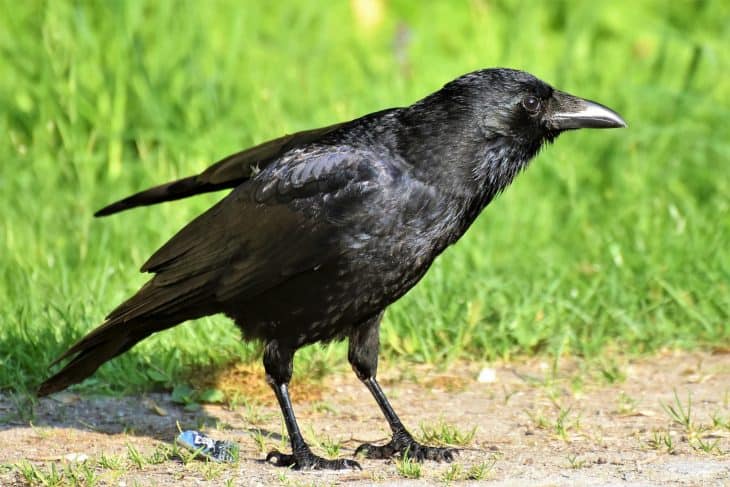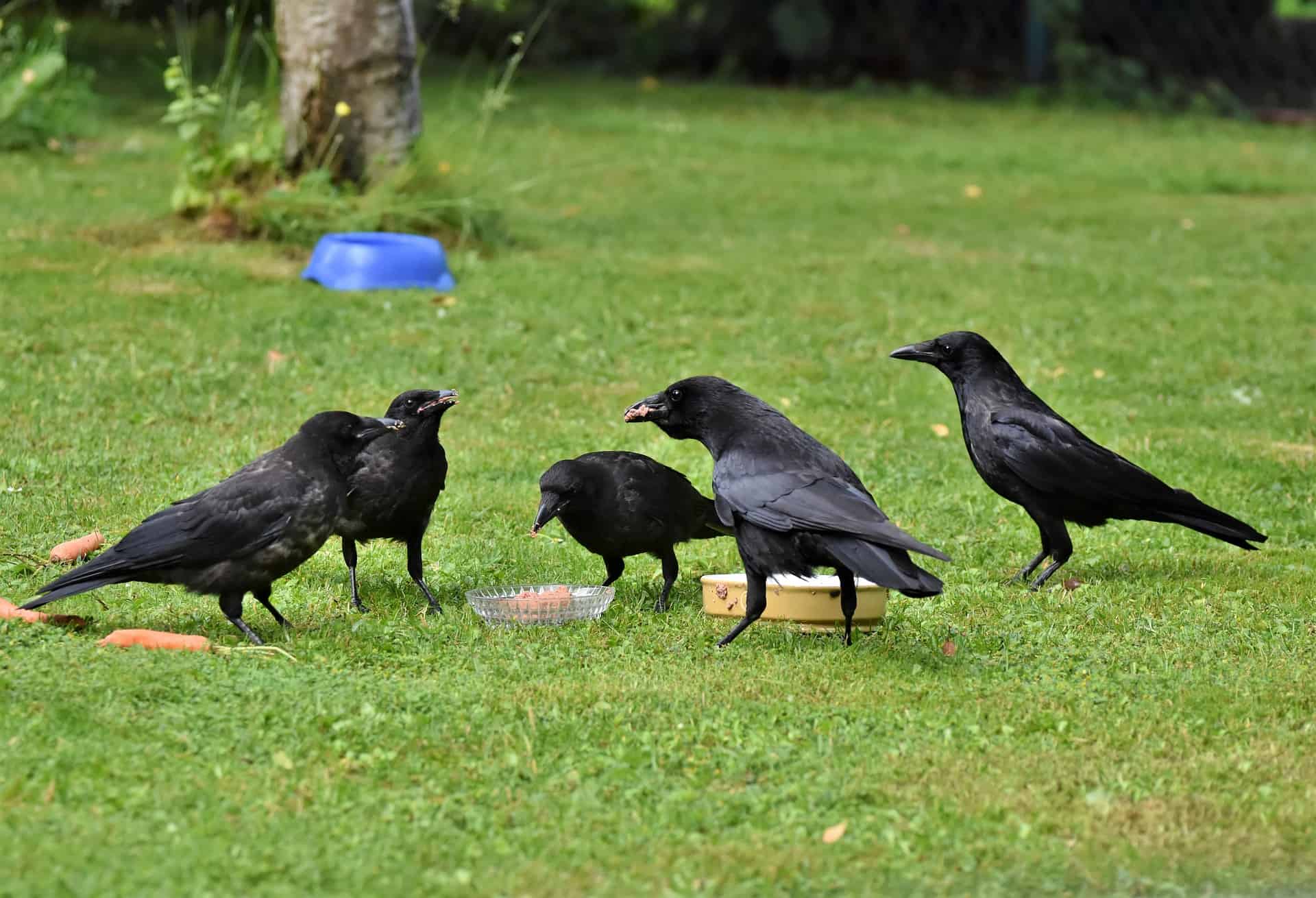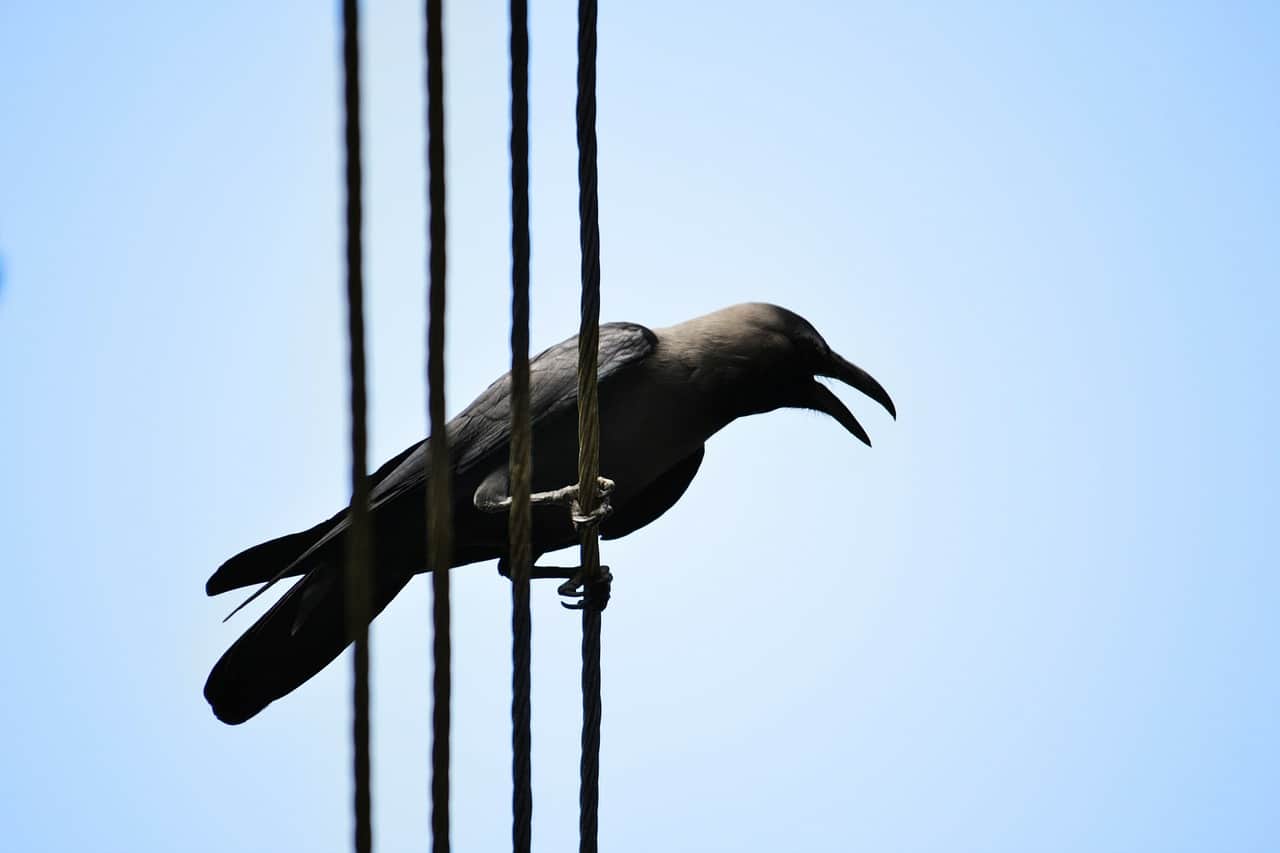
When someone says you have a bird brain, they most likely don’t mean it in a nice way. Since most of them have small brains, birds have a reputation for not being the brightest. However, it’s a different story for ravens and crows. Aside from being loud and playful birds, crows have been described as the smartest birds on Earth. Beyond their reputation as a bad omen, there’s a lot to know about these birds. Find out more about these animals with these crow facts.
- Three-legged crows can be found in Chinese, Korean, and Japanese mythologies.
- Young crows leave the nest after four weeks.
- Crows have around 250 different calls.
- Crows lay around three to nine eggs per clutch.
- Crow eggs hatch after 20-40 days.
- Crows are part of the family Corvidae.
- The genus Corvus includes crows, ravens, and rooks.
- There are around 45 species in the genus Corvus.
- Corvus comes from the Latin word for “raven”.
- Crows are omnivores.
- They are known for their characteristic “caw”.
- Crows are social animals.
- Ravens are generally bigger than crows.
- Female crows reach sexual maturity earlier than males.
- They are passerines or perching birds.
- Despite their irksome calls, crows are songbirds.
- Hunting crows is legal in some states in the USA.
- The birds of the crow family can be found on every continent except Antarctica.
- They are the largest in size among the passerine birds.
- Crows molt once a year while other passerines molt twice a year.
Crows can use tools.
Only a small minority of animals have been observed using tools, including primates, bears, elephants, sea otters, and octopuses. However, crows also use tools to look for food, often using twigs to poke for grub or carrying multiple items. How’s that for interesting crow facts?
They also make their own tools.
If using tools still isn’t enough to convince you, crows are also smart enough to create their own tools. Specifically, New Caledonian crows have been observed modifying leaves and twigs into hooks and barbed spears. These crows can also learn to make tools by memorizing and recreating their designs.
Crows also don’t restrict themselves to using one material in making tools. They also evolved to combine multiple items that are otherwise non-functional. This type of complex tool-making has previously only been observed in humans and great apes.
Crows are also goal-oriented.
Similar to the sense of achievement that humans feel after completing a task, crows also behave more optimistically after successfully using a tool. Scientists believe that like humans, crows also enjoy the process of having something to accomplish.
Crows have proportionally big brains.
The phrase “bird brain” may be a common insult rooted on birds’ lackluster intelligence, but crow brains are actually large in proportion to their bodies. The weight ratio of their brain to their body can be compared to those of dolphins and great apes. Despite their small size, their relatively big brains give them a definite advantage in intelligence.
Because of their brain size, crows also have a sharp memory, capable of remembering faces for up to half a decade. They can also remember specific colors of food containers for about a year.
A crow can also save their food for later.
Crows don’t just leave extra food lying around. When they have an abundance of food, they store them in caches for later consumption. Crows bury food in different spots or hide them in leaves and other objects. When they’re hungry again, they go back to their caching spots and retrieve the food.
Often, crows would have favorite areas to store their food, placing markers on top of their hiding spots so they can remember where they put the food. They also are aware that thieves might get their stored food, so they sometimes move them to different spots.
They know what kind of food to store first.
Some types of food go bad before others, and crows are aware of this fact. They have been observed to eat pieces of meat first, then storing types of food that don’t spoil as quickly, such as nuts or bread.
Crows know traffic rules.
For some carrion crow populations in Japan, walnuts are a favorite treat. However, walnuts are difficult to open and the crows have to drop them repeatedly onto rocks to split them open and get the delicious insides. Crows are smart, however, and they learned how to use cars as nutcrackers.
The clever crows drop the walnuts on the roads for cars to run over and crack them open. They later learned that cars stop when the traffic lights turn red. When the lights are red, the crows put walnuts in front of stopped car tires. They wait for the cars to crack open the walnuts, then they retrieve the walnuts when the lights turn red again. Definitely one of the crow facts you’d want to witness yourself.
They hold funerals for their dead.
This is one of the crow facts that are well-documented but poorly understood. When a crow dies, other crows gather around their remains, resembling a funeral.
Researchers suggest that the crows may be learning from their fallen neighbors. These funerals provide them with an opportunity to learn about dangerous situations, animals, or people.
They can recognize human faces.
You have to be careful not to treat crows badly, because they have the ability to remember human faces. They have been known to recognize humans associated with stressful situations, such as keeping them captive or killing one of their fellow crows. Once you make an impression on a crow, it can remember your face for up to five years.
Crows gossip with their peers.
Not only will they hold a grudge against you if you treat them badly, they will also share it with their neighbors. They’re known to learn about dangerous individuals through social learning and have been known to gang up on persons that other crows had a negative experience with. Even crows who had never encountered the person before will join in and react angrily as well. How’s that for relatable crow facts?

They rub ants on their feathers.
Crows exhibit a behavior called “anting”, where they look for an area with a large number of ants and rub them on their feathers and skin. The agitated ants secrete formic acid, which acts as a repellent against parasites and harmful microorganisms.
Crows mostly mate for life.
These intelligent birds are highly social and often band together in tight-knit families. A pair of crows will typically stay together until one of them dies. Both the male and female will help in building nests and raising chicks.
However, when it comes to mating, crows can be quite promiscuous — some crows will mate with other crows outside their pairing.
Young crows can help their parents raise their other chicks.
It takes a few years for young crows to leave the nest and venture on their own. Juveniles sometimes defend their baby crow siblings from predators. They can also help in feeding the chicks or giving food to their incubating mother.
They harass predators much larger than them.
To protect their territories, crows engage in mobbing behavior, or working together to chase them off. This endeavor can be loud and involves the crows swooping in to harass would-be predators or invaders.
Grouping together also allows them to take on foes much larger than them, such as hawks and owls. Sometimes, crows may even harass other animals even when they’re alone.
Crows also steal from predators.
A group of crows can also work together to get food. Scientists have documented crows pulling on the tails of predators to distract them, allowing other crows to snatch their food items.
Crows also play sports.
As social animals, crows have sometimes been observed play-fighting and jousting in mid-air. The playful birds can also play tug-of-war with other crows.
They have dialects that vary across regions.
Crows, as with other songbirds, communicate largely through complex vocalizations. Crow calls vary in tone across regions, somewhat like dialects. When a crow goes to a different region, it mimics the tone of the dominant crows in the area.
Traditional scarecrows don’t work for too long.
Farmers commonly use scarecrows to trick crows into thinking that there are humans on the field and that they should stay away. The intelligent crows quickly get used to these, however, and may even perch on them over time.

Crows can solve puzzles.
In exchange for food, crows can solve complex puzzles. One popular puzzle is known as Aesop’s Fable, which was inspired from the Greek fable “The Crow and The Pitcher” wherein a thirsty crow drops pebbles in a pitcher containing water that was too low for it to reach.
The puzzle consists of a container, some water, and a floating food item deep inside the container, too low for the crows to reach. The crows dropped sinking items into the containers, and the rising water level allowed them to get the food inside. While doing so, they largely ignored items that didn’t sink.
Crows live for a long time.
The lifespan of crows lasts around 20 years, with captive crows living longer than crows in the wild. The oldest crow documented in the wild almost reached the age of 30, while the oldest recorded captive crow lived up to the age of 59.
They are popular in mythology.
Crows can be found worldwide and they are the subject of a number of different myths, literature, and folklore. Crow symbolism varies across the world, with some saying they are carriers of good luck, while others say they bring bad luck. They have been described as bringers of omens, messages, or rain. Their black feathers and carrion-eating habits also associated them with death and witchcraft.
Crows have caused blackouts.
Japan is home to a large population of crows, and their presence in cities could spell trouble for the citizens and electricity providers. Crows build nests on power lines and transformers, often with metal hangers or cables, causing short circuits that lead to blackouts. As a solution, a power company began putting out artificial nests so crows don’t have to build their own.

They fare quite well in cities.
Crows are omnivorous and aren’t picky about their food. They will happily eat anything they come across, such as seeds, snails, worms, or even discarded human food. Cities just happen to have an abundance of resources they can use, so the birds naturally thrive in them.
It also helps that crows are generalists, not specialists. They evolved to survive in a number of different environments and are not restricted to one habitat and food source. This makes them adaptable to environmental changes. Because of this, they’re much smarter than their rural cousins. However, city crows accumulate more cholesterol in their blood because of human food.
Crows kiss and make up.
These gregarious birds are known for creating long-term relationships with one another, but they sometimes get involved in fights over food or territory. Researchers have also observed that some crows seek out the other party and attempt to apologize by touching and preening their feathers. The victims of aggression may also look for consolation from other crows.
They stay with their parents for a long time.
Most birds leave their parents shortly after learning to fly on their own, but crows tend to stay with their parents for up to five years or longer. Staying with their parents could give them an advantage when it comes to learning important survival skills.
White crows exist.
The black feathers of crows are some of their most distinctive features, but have you ever seen a white crow? Seeing one is rare because they only exist due to genetic abnormalities.
An albino crow genetically lacks the pigments responsible for the color of its feathers. This results in a white crow with red or pink eyes and legs. It often only survives till a young age because albinism comes with visual problems.
Leucistic crows, in contrast, can have completely white feathers but dark-colored eyes. It’s more common for them to only have a few white feathers, however. Moreover, some species of crows naturally have some white feathers, such as the pied crow.
Crows experience analogical reasoning.
Not only do crows solve puzzles and plan their next moves, they can also understand analogies. An analogy is a relationship of similarities and differences between objects, such as “Moon is to night as the sun is to what?”.
Between two trials, for example, if they got a reward after choosing similar objects in the first trial, they can deduce that picking similar objects for the next trial will also give them a reward. The same is true if they are supposed to pick different objects for both trials. Even without training, they can deduce the relationships of similarities and differences, which is a sign of analogical reasoning.
Crows and ravens only have subtle differences.
Telling the difference between crow and raven might be tricky, and there are some inconsistencies regarding the distinction. Belonging to the same genus, both species have similar characteristics.
It may take a keen eye to spot the difference between ravens and crows. In general, however, ravens are much larger and have deeper croaks. They also have much larger bills compared to crows. Crows also generally have fan-shaped tails, in contrast to the pointier, more wedge-shaped tails of ravens.
Crows give gifts.
One of the more comical crow facts is that you can receive small gifts when you feed and befriend a crow. One famous example is that of an eight-year-old in Seattle who formed a friendship with neighborhood crows by dropping or sharing food with them. In return, they would often leave gifts for her, in the form of small items such as buttons, pins, paper clips, and even a pearl-colored heart accessory.
Crows love being prepared.
These brainy birds are strategic and plan their moves before they act, somewhat like chess players. In experimental studies, researchers found that crows are capable of solving sequential puzzles, which would not be possible if the birds can’t plan ahead.
Was this page helpful?
Our commitment to delivering trustworthy and engaging content is at the heart of what we do. Each fact on our site is contributed by real users like you, bringing a wealth of diverse insights and information. To ensure the highest standards of accuracy and reliability, our dedicated editors meticulously review each submission. This process guarantees that the facts we share are not only fascinating but also credible. Trust in our commitment to quality and authenticity as you explore and learn with us.
